Just in case you don’t already have plenty of high-tech acronyms to juggle, we want to introduce you to the term API. No need to worry. You’re probably already using API every day without even noticing. Seamlessness and security are at the heart of API, so your everyday Facebook message or additions to your Amazon shopping cart make you an API user, whether you know it or not.
As marketers, though, we have to know a bit more about the API and its usage than the average social media user or online shopper. After all, it has the power to aid us when dealing with a wide range of data — when we’re assessing users’ site sessions, optimizing ecommerce platforms, social media, CRM, and much more.
As a company that holds powerful digital marketing data, Semrush has its own API that supports a large number of digital agencies, data science departments, research firms, SaaS software developers, and other companies and professionals dealing with large amounts of data.
This post will walk you through the ins and outs of API — from defining an API to key use cases — and focus on one of our most sought-after API types, Traffic Analytics API. By the end of the post you will be able to assess whether it’s the kind of fuel your business needs for more tangible wins.
What is an API?
APIs, or Application Program Interfaces, are a software intermediary that allows applications to communicate with each other.
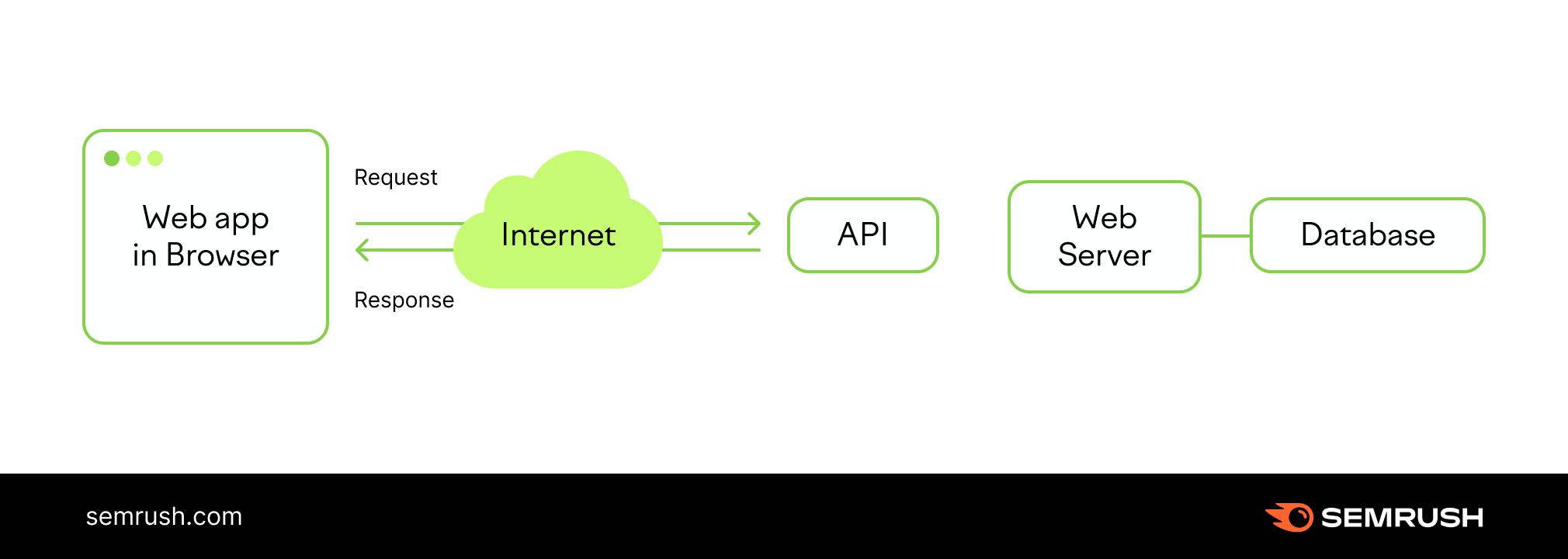
Think of it as the wire that delivers your request to the end-provider and sends the response back to you.
To use another analogy, imagine going to a restaurant. You sit down at your table and open your menu. The cooks in the kitchen are the part of the system that prepares your order, but you wouldn’t just walk into the kitchen and tell them what you want. You need a waiter! In this analogy, the waiter is the API. It takes your request to the system and brings back exactly what you want.
Essentially, APIs consist of two key components:
- Technical specification describing how one application can interact with another; and
- A software interface that allows such interaction to happen.
API is a multi-trillion dollar industry, with around 35% of the largest tech brands associating a quarter of their key revenue streams with API. There are three key ways companies use API: Private internal use, through partnerships, or public or external access.
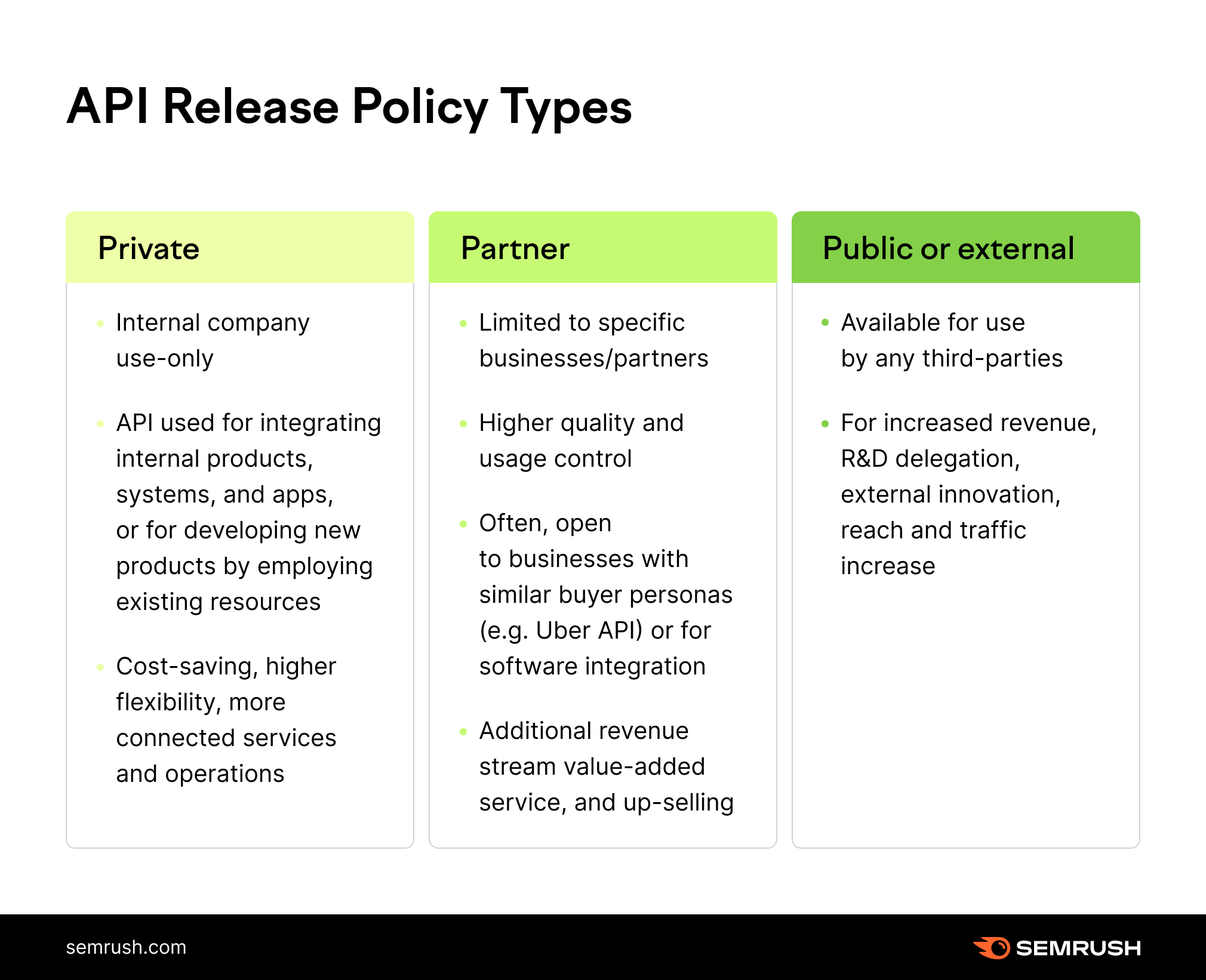
In our case, Semrush uses the partner release policy. Thus, we allow those with access to the Semrush API to gather raw data from our platform without using the standard website interface.
This way, the data-pulling process can be automated and accelerated, and the data can be seamlessly integrated into your custom reports and dashboards, or augment your software.
What Data Can Semrush APIs Offer?
Semrush offers three main API packages that can provide you with indispensable analytical data:
1. The Standard Semrush API, which includes:
- Analytics API (Domain Analytics, Backlinks Report, and Keyword Research)
- Projects API (Site Audit and Position Tracking)
2. Accounts API (remaining API units, query history, export query history)
3. Traffic Analytics API (a separate API for Traffic Analytics data)
In this post, we will focus on the Traffic Analytics API and all the key ways you can use it to your business advantage.
Key Ways to Leverage Semrush’s Traffic Analytics API
Semrush API seamlessly integrates into custom reports, custom dashboards, spreadsheets, and different analytical and data reselling platforms in no time; Traffic Analytics API is no different.
Although there are many creative and innovative ways you can benefit from the Traffic Analytics API, we will mention only a few key examples.
Powering Custom Reporting with the Traffic Analytics API
Semrush Traffic Analytics data allows you to create a large variety of reports. You can use the API in countless ways with the ease of opening a Google spreadsheet. You’ll gain the benefit of up to date traffic trends and metrics in order to tailor your strategy to current conditions.
Let’s take a look a media buying as an example:
Say you’re an advertiser with a list of domains where you’d like to place your ads. The ranking of these sites is volatile, however, so you need to prioritize them to figure out which ones may bring higher impact and visibility for your ads this month.
This is where Traffic Analytics API comes to the rescue. With that list of domains in spreadsheets, you can pull the API data on each of them and receive regular updates on real-time traffic trends and engagement metrics in order to be smart about your media-buying strategy.
Building Custom Dashboards With the Traffic Analytics API
Custom dashboards allow you to combine data from multiple sources in one visualization tool, instead of switching between dozens of reports and software applications. This is extremely useful when you need to check your advertising efforts and marketing channels’ growth in comparison with other market players.
Let’s say you promote your business on social media (Facebook, for instance). You pull the data on Facebook Analytics and Google Analytics into your Performance Dashboard and now need to compare your results to general market indicators.
Traffic Analytics API can be a source of data on any website’s traffic and provide insights on market trends. Just export the data on your competitors to Google sheets and then upload it to any report in Google Data Studio.
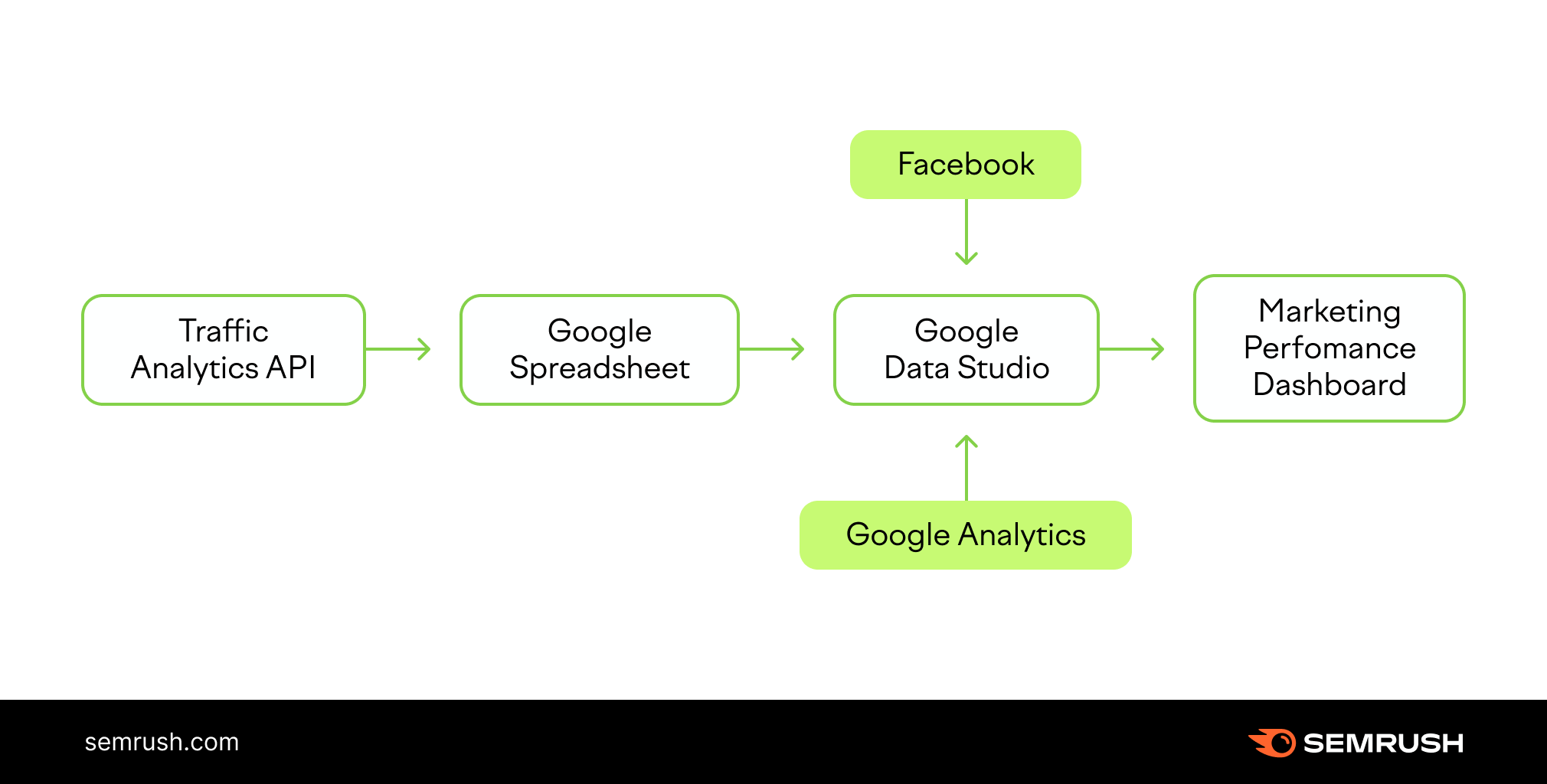
Harnessing the Power of Traffic Analytics Data for Integration Between Different Platforms
Traffic Analytics API can also integrate with sales prospecting software to give your sales team additional information about each opportunity.
Let’s go through a common efficient workflow.
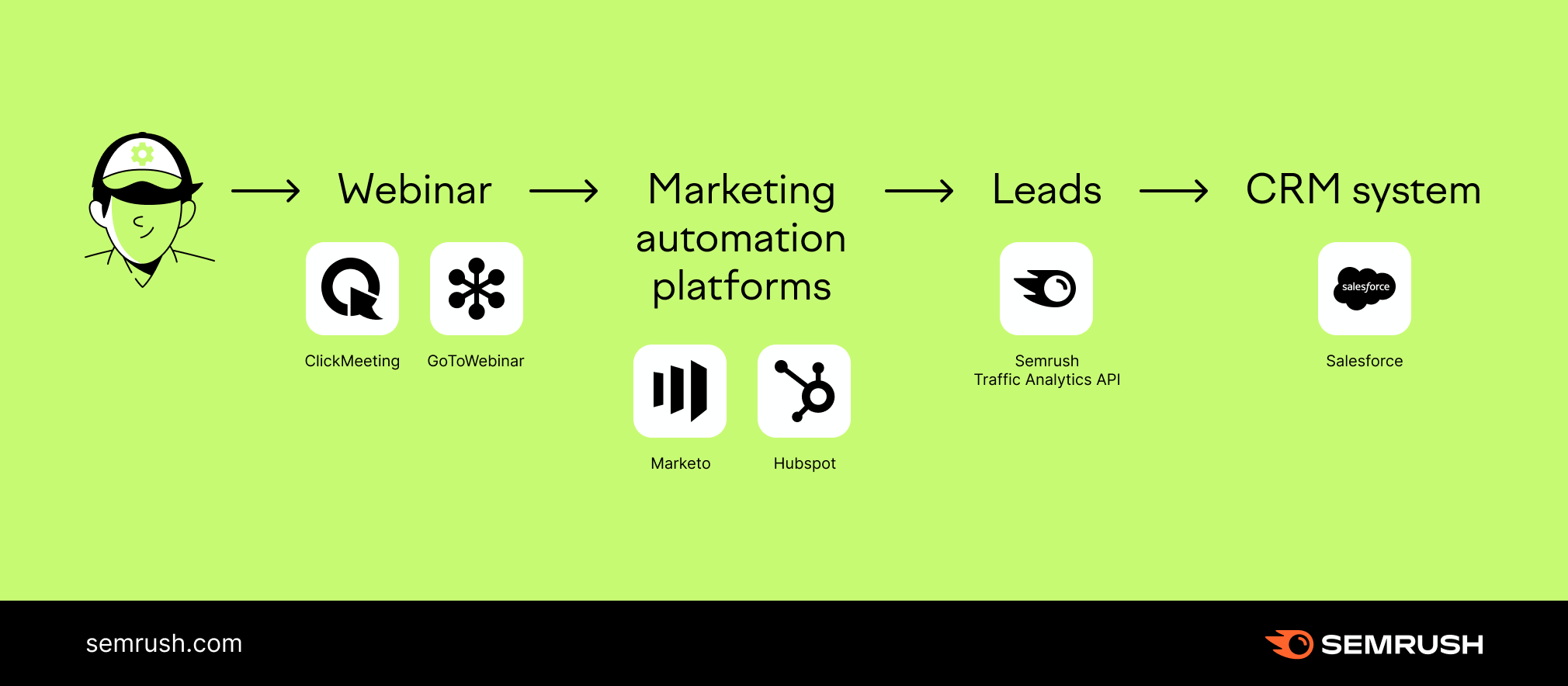
Say you’re a marketer holding a webinar via a specialized service (ClickMeeting, GoToWebinar). After it’s done, you expect your newfound leads (registrants and attendees) to be integrated into one of the marketing automation platforms (e.g. Adobe Marketo, Hubspot).
Such cross-platform integration will allow you to create newsletters, process your leads and transmit them to CRM systems (e.g. Salesforce) to provide your salespeople with some deep insights for further work.
At the stage of transmitting those leads to your sales team, Semrush data can help you to qualify and prioritize them. Just pull Traffic Overview data to see which leads have the highest website engagement and which websites show weak engagement from their visitors. The leads with the least engagement could be the best places to start if you are pitching website services.
Re-Selling Semrush Data Through a Software Service*
One of the greatest opportunities API can offer is the enhancement of your own software. Use Semrush’s high-value data to build up your own products and modify them. We have large volumes of global, diverse, and reliable data available to you through an API connection.
For instance, if you’re already offering a SaaS platform for people to analyze online business performance, market trends, or competitive research, adding Semrush Traffic Analytics to your pool of data can bring powerful insights into any business’s online presence and visibility.
*The use of Semrush API is subject to Semrush Terms of Service, available at: https://www.semrush.com/company/legal/terms-of-service/. If you wish to resell Semrush data, you should contact Semrush by e-mail at mail@semrush.com and request information about becoming a Semrush data reseller. You may not, directly or indirectly, resell Semrush data until the terms of reselling are agreed with Semrush in a written agreement signed by Semrush and you.
Leveraging Additional Metrics for Measuring Business Potential
Some companies use Semrush metrics to evaluate and validate potential investments in a new business. One of them is Flippa, a prosperous marketplace selling online businesses.
Flippa showcases Semrush’s data within each business listing to help their buyers make smarter and more informed business and investment decisions based on reliable data — from traffic estimates to insights on organic and paid search performance, backlink profiles, and competition.

Developing Better Agency Pitches for Prospective Clients
Agencies often use Semrush metrics to gather more compelling and comprehensive data on their prospect’s markets, their market share, and the best growth opportunities. Pitching potential clients with in-depth knowledge of the client’s industry and competitors builds confidence and increases the likelihood of landing the job.
One such example is Impression Digital, a digital marketing agency located in the UK. They used Semrush .Trends data to prepare pitches that showed:
- Client performance and growth potential: using Market Explorer, they were able to pinpoint the causes of recent traffic growth, benchmark company growth against the market, gather insights about future growth trends, and make recommendations about future marketing efforts.
- Traffic sources and competitor comparisons: They looked at traffic sources to understand whether the client was over-indexed or under-indexed in the search channel compared with its competitors. Discovering that the market, on average, was driving more traffic via organic search percentage-wise, they confirmed that investing in SEO was the right decision at that time.
- Top Opportunities: Using Traffic Analytics, they identified and qualified top opportunities by exploring data related to site traffic growth, link building, and traffic journeys. This data helped them discover less obvious opportunities, pinpoint the best potential options, and coach their clients based on discovered insights.
With this strategy, they were able to win 11 opportunities worth nearly 500K. They now offer their clients unique market insights, comprehensive presentations that take half the time and effort to build, and roadmaps for future strategies from the first contact with clients.
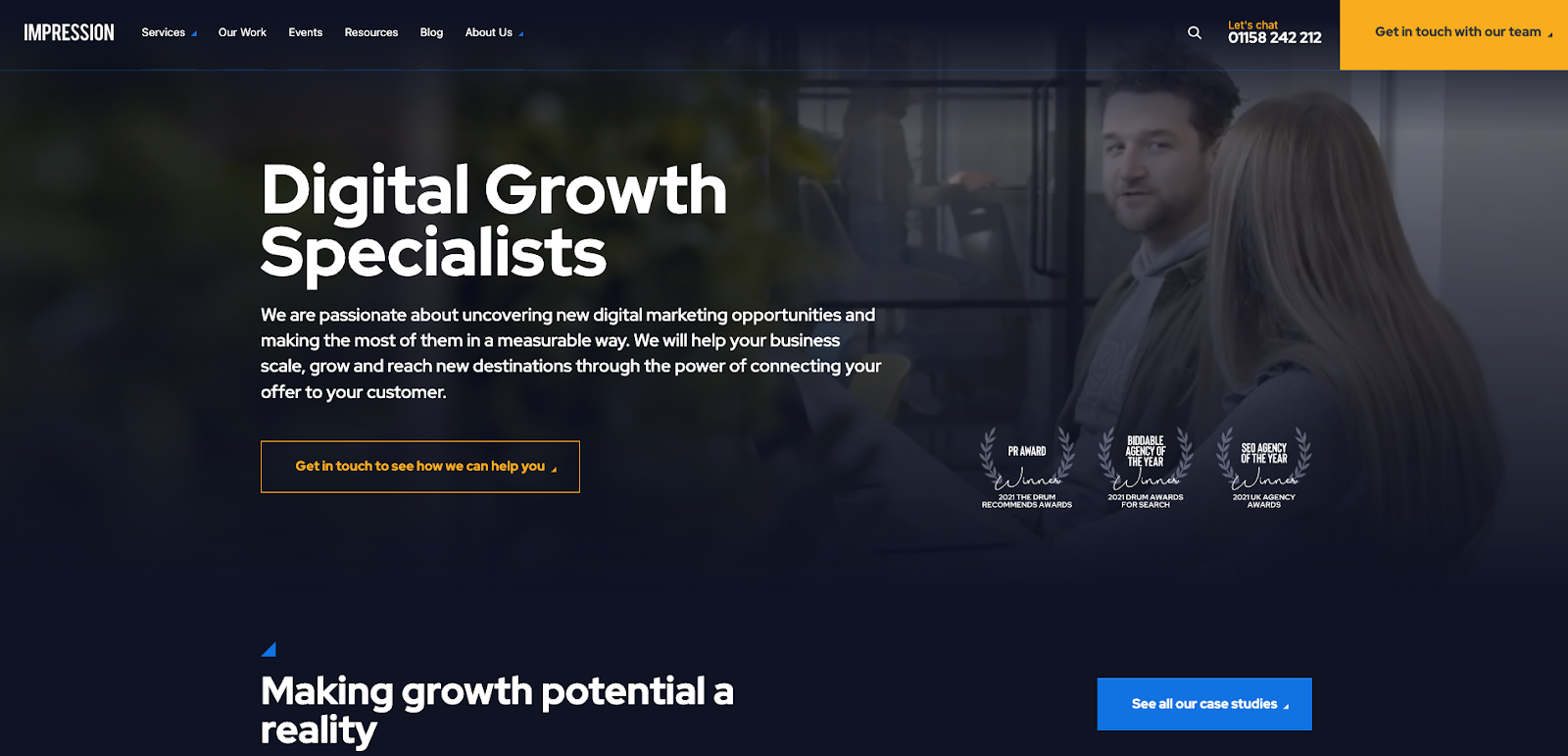
Read more about how agencies use Semrush.
How Does an API Enhance My Business?
APIs are often compared to LEGO, where you use building blocks consisting of various data points to create something of your own. With over 21,000 public APIs, this large amount of data you can access for various applications holds the key to higher efficiency, more agility, and accelerated innovation.
From Google Maps to Salesforce analytics, third-party APIs provide your business with new functionality, cost savings, and business optimization tools. Because instead of writing your own software and investing in R&D, you can simply purchase all the necessary data access points and integrate them with internal analytics, and your own products and software.
Think of it like outsourcing certain roles to more high-performing and cost-efficient employees.
Thus, the most obvious reason for implementing Application Programming Interfaces is to increase income.
But there are certainly other reasons:
APIs can be key for business process automation since they enable companies to easily provide controlled access to a defined scope of data or functionality.
By automating different processes, businesses can become smarter, faster, and more efficient. The result is satisfied customers, better-performing staff, and a higher profit margin. Plus, you spare yourself more time to spend on analytics instead of collecting large volumes of data manually.
APIs as an open door to success
API systems provide an automated way for partners to integrate using data. Professionals and companies around the globe can improve products and services with the experience and expertise of third-party API providers.
Think of an API as an open door to all those new opportunities that can help enrich company products, improve operations, solve unfamiliar problems, and more.
API for Innovation
Big innovative players like Google, Facebook, Twitter, Uber, Stripe, and Amazon are known to spend significant resources on APIs since these technologies create room for future innovations. Barriers to change become smaller and more people can contribute to an organization’s success.
Let’s take Uber as an example: instead of building its own mapping, payment, or communication services, the company used the best of those programs and connected to them via APIs. In return, Uber's API empowers its users in the following ways:
- No need to spend money and effort on building an app from scratch. All you need is a reasonable connection and system setup.
- No more dealing with tech documentation', searching for taxi partners, signing contracts with drivers, etc. Businesses can just use the Uber API as the foundation for their service.
- Possibility to exchange or share your current location. The Uber API is used to notify other users about your location in real time. This data can be easily applied to social networking projects or messaging services.
Over to You
While API integrations do require a certain level of tech-savviness, it’s certainly a worthy investment for any business that could use additional data to enhance internal operational performance or products intended for external use.
Semrush has built an intuitive and easy-to-use API system, where the benefits you can see for your business far outweigh the level of complication of API integration.
In the case of Semrush Traffic Analytics API, a simple one-time effort can help you:
- Monitor the market and performance of your competitors;
- Evaluate markets and potential business partners and investments;
- Qualify your leads at hyperspeed;
- Equip your sales team with data on prospects;
- Enhance your SaaS offering with Semrush data;
- Detect fraud and misrepresentation when making investment decisions.
If you choose to fuel up your business with Semrush’s API and come up with new innovative ways to use our Traffic Analytics API, make sure to let us know, and your unique approach or the next big idea can be featured within this post!
